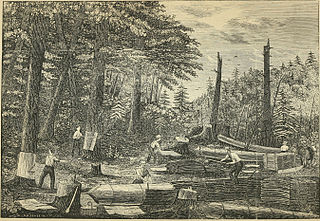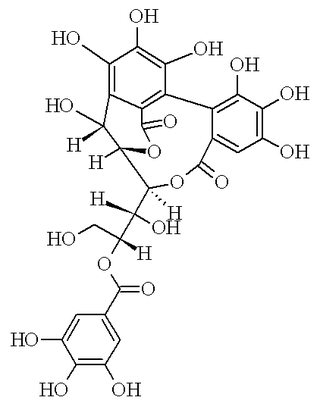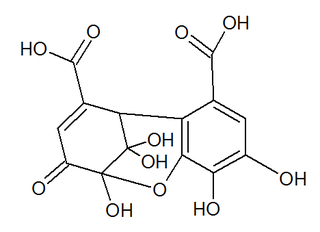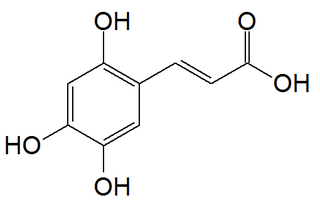Related Research Articles

Senegalia berlandieri is a shrub native to the Southwestern United States and northeast Mexico that belongs to the Mimosoid clade of Fabaceae. It grows 1 to 5 metres tall, with blossoms that are spherical and white, occurring from February through April. The berlandieri epithet comes from the name of Jean-Louis Berlandier, a French naturalist who studied wildlife native to Texas and Mexico. S. berlandieri contains a wide variety of alkaloids and has been known to cause toxic reactions in domestic animals such as goats.

Vachellia rigidula, commonly known as blackbrush acacia or chaparro prieto, and also known as Acacia rigidula, is a species of shrub or small tree in the legume family, Fabaceae. Its native range stretches from Texas in the United States south to central Mexico. This perennial is not listed as being threatened. It reaches a height of 5–15 feet (1.5–4.6 m). Blackbrush acacia grows on limestone hillsides and canyons.

Tanbark is the bark of certain species of trees, traditionally used for tanning hides into leather.

Prodelphinidin is a name for the polymeric tannins composed of gallocatechin. It yields delphinidin during depolymerisation under oxidative conditions.
A Proguibourtinidin is a type of condensed tannins formed from guibourtinidol (leucoguibourtinidin). They yield guibourtinidin when depolymerized under oxidative conditions.

Castalagin is an ellagitannin, a type of hydrolyzable tannin, found in oak and chestnut wood and in the stem barks of Anogeissus leiocarpus and Terminalia avicennoides.
Flavonolignans are natural phenols composed of a part flavonoid and a part phenylpropane.

Mesquitol is a flavan-3-ol, a type of flavonoid.

Cassia abbreviata, commonly known as the sjambok pod or long-tail cassia, is a mostly tropical tree species in the genus Cassia, which is native to Africa.

Punicacortein A is an ellagitannin, a polyphenol compound. It is found in the bark of Punica granatum (pomegranate) and in Osbeckia chinensis.

Osbeckia chinensis is a plant species in the genus Osbeckia.

Sanguisorbic acid is a constituent of some ellagitannins. It is constituted by a hexahydroxydiphenic acid unit linked by an O-C bond to a gallic acid. The differences with its isomers, valoneic acid and nonahydroxytriphenic acid, are that the hydroxyl that links the hexahydroxydiphenoyl (HHDP) group to the galloyl group belongs to the galloyl group in valoneic acid, while in nonahydroxytriphenic acid, the hexahydroxydiphenic acid unit is linked by a C-C bond to gallic acid.

Senegalia caffra, also known as hook-thorn or Acacia caffra, is a tree that occurs commonly in southern Africa. Though it is cultivated, it often occurs naturally in Gauteng suburban gardens, together with Acacia karroo and Acacia robusta.

Combretum paniculatum, the burning bush or forest flame-creeper, is a plant species in the genus Combretum found in Africa. The fruit is a samara, i.e. a winged seed.

Mallotusinic acid is a hydrolysable tannin found in the bark of Mallotus japonicus. It is more generally present in Geraniales.

Anhalidine is a naturally occurring tetrahydroisoquinoline based alkaloid which can be isolated from Lophophora williamsii; it has also been detected other cactii and several species of Acacia. It is part of a family of compounds that are structurally related to mescaline.

Dehydrohexahydroxydiphenic acid is a group found in dehydroellagitannins. It is formed from hexahydroxydiphenic acid (HHDP) through oxidation of the plant hydrolysable tannins. It is found in ellagitannins such as euphorbin A, geraniin or mallotusinic acid.

2,4,5-Trihydroxycinnamic acid is a hydroxycinnamic acid found in rooibos tea. cis-2,4,5-Trihydroxycinnamic acid can be isolated from seeds of Alisma orientale.
Promelacacinidin is a polymeric condensed tannin composed of mesquitol. This type of tannin can be found in Senegalia caffra.

Oritin is a flavan-3-ol, a type of flavonoid. It is a component of the proteracacinidin tannins of Acacia galpinii and Acacia caffra.
References
- ↑ Bennie, Linette; Malan, Elfranco; Coetzee, Johan; Ferreira, Daneel (2000). "Structure and synthesis of ether-linked proteracacinidin and promelacacinidin proanthocyanidins from Acacia caffra". Phytochemistry. 53 (7): 785–793. doi:10.1016/s0031-9422(99)00618-4. PMID 10783984.
- ↑ Malan, Elfranco (1995). "A (4β → 5)-linked proteracacinidin dimer from the heartwood of Acacia caffra". Phytochemistry. 40 (5): 1519–1521. doi:10.1016/0031-9422(95)00440-I.
- ↑ Malan, Elfranco; Sireeparsad, Ashika; Burger, Johann F.W.; Ferreira, Daneel (1994). "A novel doubly-linked proteracacinidin analogue from Acacia caffra". Tetrahedron Letters. 35 (40): 7415–7416. doi:10.1016/0040-4039(94)85329-0.